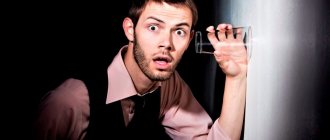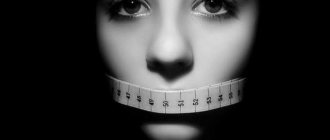- KtoNaNovenkogo
- FAQ
- Are you here
May 4, 2019
- What is a flashback in cinema?
- In literature
Hello, dear readers of the KtoNaNovenkogo.ru blog. New words appear in our language almost every day. We have already become accustomed to many of them, but some still remain beyond our understanding.
Agree, in order to feel confident in any society, it is important to pay attention to new words and terms. One of these mysterious words is flashback.
Let's figure out what it means and in what cases it is used.
What is a flashback
Like all fashionable expressions, this word is of English origin. Flashback is translated as - flash “flash, insight” and back “back”. Simply put, this is a flash from the past , a fragment of what once was.
Flashback is a word that is now actively used in several directions at once. Let's look at each of them in detail.
Flashback in cinema is...
The term flashback is most often used by screenwriters in cinema. This is a well-known artistic technique, during which we see footage from the past. As a rule, these are the main character’s memories of some elements of his biography: fragments from childhood, memories of a disaster, etc.
Flashback is a technique (insertion of a fragment) in cinema that helps the viewer briefly become familiar with the background of events.
In films, this technique allows viewers to understand a lot about the characters’ characters, behavior and destinies in a short period of time.
Sometimes such scenes from the past are tinted sepia to achieve . ”
What is a flashback for?
Explanation A flashback reveals a fact about the hero, complements his characteristics, explains his motivation, or provides information necessary for understanding the plot. Such flashbacks, as a rule, are rare, as they can confuse the viewer, disrupting the consistent narrative. Accelerating history Flashback allows you to shorten the story, because with the help of this technique the characters can move from one time to another immediately, without stretching out several additional episodes. Revealing the truth
Scene from the film “The Best Offer” (Giuseppe Tornatore, 2014) Using a flashback, you can reveal the true picture of events. There are two main options here: the truth can be revealed gradually, through a series of flashbacks, as in the film “I Am Legend,” or it can be revealed with the help of a single flashback, most often representing a final twist. For example, in Giuseppe Tornatore’s film “The Best Offer,” such a decision completely changes the meaning of the entire story.
Intrigue
Scene from the film “Casino” (Martin Scorsese, 1995) Flashback as a way to create intrigue and arouse interest in watching the movie further. The viewer wants to find the answer to the question: “How did the hero come to this?” For example, Martin Scorsese resorts to a similar technique in Casino. The picture begins with the explosion of a car with the main character inside. The subsequent narration is an attempt to trace how the character ended up in this situation. Character of the story Still from the film “Rashomon” (Akira Kurosawa, 1950) Since a flashback is usually associated with the motif of memory, it is used as a reason to reflect the subjective perception of the world. For example, in Akira Kurosawa's film Rashomon, the same story is interpreted differently by four heroes. Accordingly, the viewer is asked to come to terms with the fact that truth does not exist, or to understand that it is somewhere in the middle. However, sometimes authors do exactly the opposite, making the flashback an objective, detached and true view of history. This kind of technique can be seen in the finale of “Fight Club,” which demonstrated the madness of the main character, as well as in the TV series “Lost.” Plot element Still from the film Memento (Christopher Nolan, 2000) Flashback can be used as a conceptual plot element. That is, its very presence constitutes the meaning of the story and determines the entire nature of the narrative. One of the earliest examples of this approach is Orson Welles' Citizen Kane. The film is a series of flashbacks - different people remember the main character, creating a mosaic image of an extremely contradictory personality. Another example is Christopher Nolan's Memento, where a complex dramatic structure consists of two narrative lines, one of which is flashback (preceding events are shown), and the other unfolds in reverse order (essentially, flashback after flashback).
In literature
In works of fiction, flashbacks perform the same function as in cinema. You've probably noticed that many stories contain inclusions from the past . All this can be confidently called flashbacks.
This technique performs a very useful function. It serves as a link between the main action of the work and the inner world of its characters. It also helps readers better understand the plot of the story itself.
Types of flashbacks
Story
Scene from the film “Jaws” (Steven Spielberg, 1975) A conventional type of flashback, since it does not involve transferring the action to the past - the hero simply talks (sometimes in a few words, sometimes in a lengthy monologue) about what happened. Despite the simplicity of the technique, many screenwriters and directors admit that this is the most preferable type of flashback, since it does not break up or complicate the narrative. A compelling example of this is the famous shark attack monologue from Steven Spielberg's Jaws.
Illustration
Scene from the film “Fight Club” (David Fincher, 1997) A fragmentary flashback that serves as an illustration of a certain episode from the hero’s past. A conventional example is the answer to the detective’s question about what the hero did last night. Another option is unexpected flashes of memories that arise in the hero’s mind and reflect his state, as, for example, in “Fight Club”. Framing In this case, a certain fragment from the past precedes the main action, making it clear the character of the hero and the actions that we will observe throughout the film. This is how flashback is used in Braveheart. Preview
Scene from the film Trainspotting (1996) The film begins with a certain episode that precedes a certain part of the story. This is how Danny Boyle likes to open his films. Let's remember Trainspotting. Crucial moment
Scene from the film “Enter the Void” (Gaspar Noe, 2009) Flashback reproduces a certain moment in the characters’ past that radically changed their lives. Sometimes such an episode is used as a refrain, repeated throughout the entire picture. This is exactly how Gaspar Noe used flashback in “Enter the Void”: there, a car accident became a turning point in the lives of the characters. The whole movie is a flashback Still from the film “Eternal Sunshine of the Spotless Mind” (Michul Gondry, 2004) Some films are technically almost entirely flashbacks. A common scheme is that the main character, acting as a narrator, recalls a certain story from the past. An early example of this approach is The Cabinet of Dr. Caligari. Perhaps one of the most inventive films with such a solution is Eternal Sunshine of the Spotless Mind. And, of course, an example on the surface is the Titanic. Flashback within a flashback Still from the film “The Discreet Charm of the Bourgeoisie” (Luis Buñuel, 1972) The pinnacle of flashback mastery. A complex dramatic construction, when within one story from the past another one arises. John Ford resorted to this in “The Man Who Shot Liberty Wales,” Joel Schumacher in “The Phantom of the Opera,” or the already mentioned Luis Buñuel, for example, in “The Discreet Charm of the Bourgeoisie.”
Sources
- https://KtoNaNovenkogo.ru/voprosy-i-otvety/fleshbek-chto-ehto-takoe.html
- https://fb.ru/article/187859/chto-takoe-fleshbek-znachenie-slova-fleshbek
- https://depressio.ru/slovar-terminov/53-fleshbek.html
- https://ezy-life.ru/simptomy-i-rasstrojstva/chto-takoe-fleshbek-i-nuzhno-li-ego-boyatsya.html
- https://tvkinoradio.ru/article/article9350-priemi-fleshbek
Flashback is also a psychological phenomenon
In psychiatry and psychology, this term has a completely different meaning.
A flashback is a very realistic memory that arose by chance, against the will of a person. As a rule, these are unpleasant experiences from the past that have left a deep mark on the psyche.
They often occur in military personnel who have suffered severe emotional shock in hot spots.
Sometimes difficult memories are so realistic that during a flashback people have difficulty noticing the difference between reality and visions.
Due to the fact that boundaries are erased, a person may behave inappropriately: scream, close himself off from an imaginary danger, or, conversely, become aggressive, which can harm others.
The duration of this state can vary from a few seconds to several hours.
According to medical standards, a person with such symptoms is diagnosed with PTSD syndrome (post-traumatic stress disorder).
Meanwhile, not only those who experienced terrible events can immerse themselves in past experiences. This phenomenon often occurs in individuals with hyperirritability syndrome.
In addition, people who have lost their memory may experience flashbacks in the form of memories of a past life.
Symptoms
It is characterized by involuntarily arising ideas. The emerging pictures evoke various emotions in a person, and the experiences of the past are transferred to the present. This psychopathological phenomenon is constantly repeated, and a delay in experiences is possible. Among the main signs of this phenomenon are:
- Uncontrollability of the appearance of flashes of the past - a person cannot control the appearance of images; they arise without any volitional effort on the part of the patient, contrary to his wishes. But the appearance of images can be provoked by starting to fantasize. A person in his fantasies can lose his volition and allow the emergence of images of a traumatic situation he experienced.
- Sensuality of experiences (sensorialization). In the process of thinking and experiencing emerging pictures of the past, a person can perceive them quite literally. A high degree of realism is achieved through sensory processing of images in thinking down to the smallest detail. For example, a veteran may remember what color buttons were on his shirt at the time of the explosion, and so on.
- Affectively rich feelings of experiencing the situation and images. When images of a psychotraumatic situation arise, a person cannot remain indifferent, his emotional state changes. He becomes vulnerable, anxious, fear appears, sometimes panic, insomnia sets in, and a conversation with himself is possible. The appearance of a person reveals the emotional richness of his experiences.
- The phenomenon in some cases is accompanied not only by visual or acoustic images (when a person sees or hears what happened in the past), but also possible tactile or olfactory components. The patient may feel the smell that was present during stress, especially if it was intense.
Additional meanings
Narcologists are well aware of another meaning of this word.
Flashback is a condition during which drug addicts have very realistic experiences associated with recent drug use.
This is explained by the fact that any narcotic substance that has a very strong psychological effect on a person can provoke a “ reverse frame ”.
Drug flashbacks are quite common. Especially among lovers of hallucinogens and psychedelics.
Therefore, the expression “catch a flashback” is common among drug addicts, meaning to experience all the signs of drug intoxication at the moment when the effect of the drug has already ended (after several hours or even days).
The duration of such a stupefying flashback ranges from a couple of seconds to several minutes.
Any factor that will remind you of the high you experienced can provoke repeated euphoria: sound, smell, environment.
It's worth noting that Flashback has several other meanings :
- Flashback is a computer game.
- A computer program for capturing video from a monitor screen.









